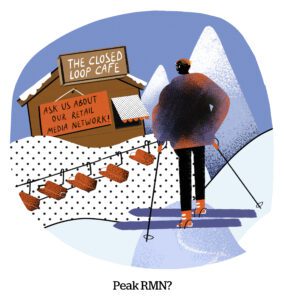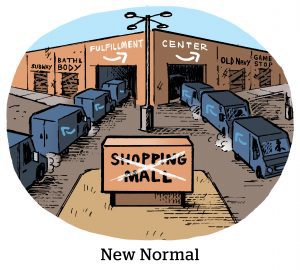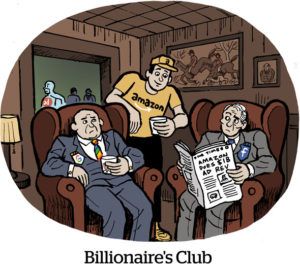Hey Readers,
I’m James Hercher, AdExchanger Senior Editor, and we’re coming in hot with this week’s edition of the Commerce Media Newsletter.
In case you’ve been on a cross-world flight, under a rock or just awoke from a coma today, Walmart announced plans to acquire TV manufacturer Vizio on Tuesday in a $2.3 billion deal.
Twenty years ago, this deal would result in a Black Friday blockbuster. Back when people camped in line to get the lowest-priced TVs of the year, Walmart could have put a Vizio in most American homes.
Fast-forward to today, and what we have is a programmatic advertising and data acquisition, dressed up as smart TV manufacturing.
The Walmart Vizio-n
Don’t get me wrong – Walmart is going to sell a lot of Vizio TVs. But its bigger interest in Vizio stems from data and advertising.
Vizio has a large and lucrative data licensing business for its automated content recognition (ACR) data. And the Walmart acquisition could upend the current state of ACR – which, by the way, is already a mess. TV manufacturers and CTV operating systems – Samsung, LG, Roku and Vizio, namely – offer ACR data, but it’s all incompatible. That’s a big problem for TV advertisers trying to understand true reach and frequency.
ACR data is powerful because it’s difficult, if not impossible, for advertisers to uncover where CTV ads ran. A linear TV advertiser knows exactly where and when their ads played, what show was on and what other advertisers shared the same break.
A Netflix advertiser knows … nothing. Likewise, Roku, Fire TV and YouTube all prohibit CTV advertisers from parsing where their ads were served. (This isn’t always bad, by the way – some advertisers were shocked and delighted last year to discover their YouTube ads served to tentpole TV, including the Women’s World Cup or the NFL.)
But smart TV sets come with a microphone and camera, which can effectively piece together what programs people watched and which ads were served.
ACR data has constricted greatly in the past few years, as TV manufacturers realize what they have and either launch their own first-party businesses or license to fewer partners. Vizio itself has an exclusive ACR data-sharing agreement with the Yahoo DSP (when it was still Verizon Media) that went into effect in 2022.
In 2021, The Trade Desk was the only other DSP with access to Vizio’s ACR data. But Vizio pulled that access when Verizon took the exclusive rights.
Funny how the ball keeps bouncing. Because Yahoo is undoubtedly going to be stripped of that data the second its deal with Vizio is up for renewal, and the exclusive ACR rights will presumably go to the Walmart Connect DSP (on The Trade Desk).
 The closed-loop play
The closed-loop play
While Vizio comes with some ad inventory of its own, the real magic for Walmart comes from the ability to connect CTV ads to actual in-store purchases.
Walmart has been trying to assemble a network to make that work for almost two years.
In 2022, Walmart Connect created what it calls the Innovation Partners program, with Roku, TikTok, Snap, TalkShopLive and Firework – all of which are about attributing video or CTV ads to Walmart store sales.
Walmart doesn’t need a one-to-one connection on sales, either. Vizio has more than 18 million opted-in TV accounts. Not all Vizio owners are Walmart shoppers, and even fewer are Walmart+ members who can be very effectively tracked across channels.
Walmart just has to show statistically sound data connecting store sales lift to CTV campaigns.
Plus, Walmart and Vizio have a big advantage over Amazon and Fire TV in one regard: Walmart.
Every major food and beverage brand is carried in Walmart stores. Most of them are on Amazon, too, but the vast majority of grocery sales still happen at a store.
Coca-Cola or Hershey’s, say, are both on Amazon. But their ad spend on Amazon is limited by the fact that they really don’t sell that much on the marketplace. And Amazon’s Whole Foods stores don’t carry most of those brands or sell as many of the perishable products most grocery shoppers look for.
Right now, brands like Coke or Hershey’s are obligated to commit a certain percent of all sales with Walmart back to Walmart advertising. (This is an age-old contractual arrangement so retailers can promote or discount items in their stores.) If Walmart can demonstrate its DSP placements drive a solid, reliable return in the form of in-store sales, those advertisers will vastly expand their budgets from the traditional shopper marketing silo to the whole CMO purview, from national branding to direct response.
The TV pipe dreams
Walmart’s retail media closed loop and ACR data from Vizio would (presuming the deal is approved by regulators) change how many advertisers buy and attribute CTV right now.
But there are other hypothetical growth opportunities that attracted more national media attention. Namely, shoppable TV ads.
QR codes and buy-now buttons within ads can enable audiences to jump to a product listing page or add something to an online cart. With Vizio, Walmart can try similar placements.
But those are largely unproven tactics. QR codes remain a gimmick of sorts and not a major traffic source for online shopping.
And, again, Walmart doesn’t need Vizio ads to drive immediate, deterministic sales. Walmart Connect needs to prove that its streaming ads correlate to a profitable increase in store sales.
With the Amazon marketplace, the Fire TV business and Freevee, an ad-supported streaming service that runs special ad placements featuring Amazon star ratings and the ability to add to cart, Amazon still hasn’t created a loop where CTV units themselves generate sales.
The Walmart exec team, which reported earnings on Tuesday, isn’t elaborating on its ambitions for the smart TV business since the deal still needs to close. But the early indicators are that Walmart will take a walled garden mentality with the new data and ads asset.
“We are really excited about the opportunity to bring together Vizio’s operating system within our ad platform,” CEO Doug McMillon told investors.
Earlier in the investor call, McMillon said Vizio would enable Walmart Connect to “connect more dots” for advertisers.
Walmart’s net sales in stores was up only 3% year over year in 2023, but its profitability (and its market cap) are up by much more than that.
Connecting dots on behalf of advertisers can actually be more lucrative than generating more store sales.
And that’s the Vizio angle.

















